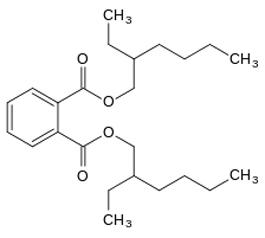 What is Bis(2-ethylhexyl)phthalate?
What is Bis(2-ethylhexyl)phthalate?
Also known as DEHP. DEHP is a colorless liquid with almost no odor. DEHP is present in plastic products such as wall coverings, tablecloths, floor tiles, furniture upholstery, shower curtains, garden hoses, swimming pool liners, rainwear, baby pantsinfant pants, dolls, some toys, shoes, automobile upholstery and tops, packaging film and sheets, sheathing for wire and cable, medical tubing, and blood storage bags.
Uses
The major use of DEHP is in the production of PVC and vinyl chloride resins, where it is added to plastics to make them flexible
Sources & Potential Exposure
The most probable route of exposure to DEHP is through food, with an average contribution of DEHP from food of 0.25 milligrams per day (mg/d). DEHP migrates into food from plastics during processing and storage. Exposure to DEHP can also occur during certain medical procedures, such as blood transfusions and kidney dialysis and use of respirators. In one study, DEHP was found in drinking water, at levels ranging from 0.04 to 30 parts per billion (ppb). The average ambient air concentration of DEHP is very low, with < 0.002 ppb in urban areas. DEHP levels in indoor air in a newly painted room or a room with recently installed flooring could be higher than levels in the outdoor air.
Occupational exposure to DEHP may occur for those workers in factories that manufacture or use the chemical. It exhibits low toxicity from acute (short-term) and chronic (long-term) exposures. Acute exposure to large oral doses of DEHP can cause gastrointestinal distress in humans. No information is available on the chronic, reproductive, developmental, or carcinogenic effects of DEHP in humans. Animal studies have reported increased lung weights and increased liver weights from chronic inhalation exposure to DEHP. Oral exposure has resulted in developmental and reproductive effects in rats and mice.
Federal Regulations
EPA has classified DEHP as a Group B2, probable human carcinogen

 Americas
Americas Europe
Europe Français
Français Deutsch
Deutsch Italiano
Italiano Español
Español



